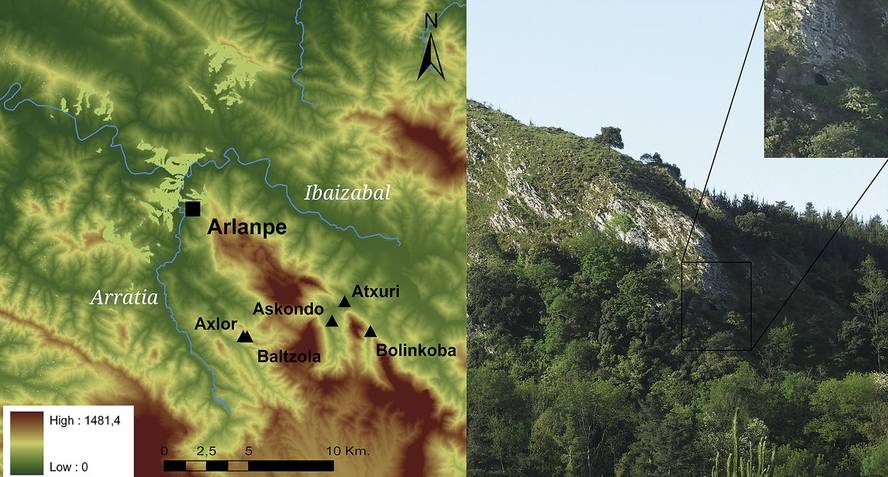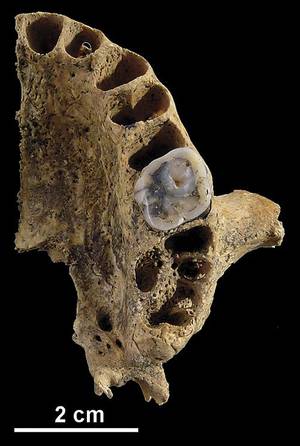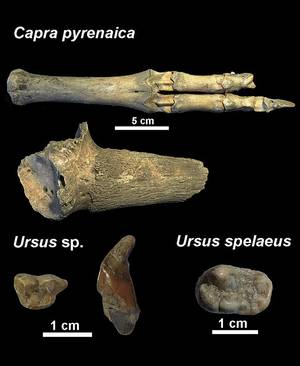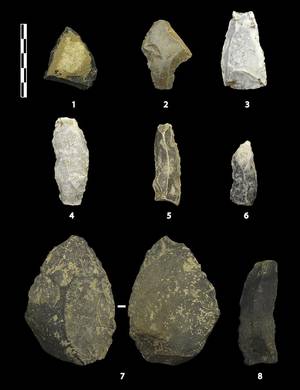2014/07/01
310. zenbakia

eu es fr en cat gl
Aparecerá un contenido traducido automáticamente. ¿Deseas continuar?
Un contenu traduit automatiquement apparaîtra. Voulez-vous continuer?
An automatically translated content item will be displayed. Do you want to continue?
Apareixerà un contingut traduït automàticament. Vols continuar?
Aparecerá un contido traducido automaticamente. ¿Desexas continuar?
Arlanpe: four windows to understand the prehistory of Biscay
Text created by automatic translator Elia and has not been subsequently revised by translators.
Elia Elhuyar
The Provincial Council of Bizkaia has recently published in the series BAI (Archaeological Excavations of Bizkaia) a book on the site of Arlanpe, in which the main results of excavations and investigations carried out during the period 2006-2012 are presented. The cave of Arlanpe is located in Lemoa, on the right end of the Arratia River, west of the Atxa de Arlanpe. Currently, the mouth of the cave opens to the northeast. Despite not being easy to arrive, the archaeological "treasures" found in the place have been worth it. About 20 volunteer archaeologists participated in the excavations, and the research work has been carried out by 20 other researchers from different research centers. The coordination of the work has fallen in the following members: Joseba Ríos Garaizar, from the Centro de Investigación sobre Evolución Humana de Burgos (CENIEH), Diego Garate from the Museum of Archaeology of Bilbao, and Asier Gómez Oliexperiencia, from the Museum of Natural History of Paris.

Location of Arlanpe with respect to other sites of the area and location of the cave in Atxa de Arlanpe. Ed. Joseba Ríos
The Arlanpe site is located in the valley of Arratia, in the municipality of Lemoa. Although the site was discovered in 1961, its true archaeological potential was revealed with the first surveys carried out in 2006. In general, we can say that the cave of Arlanpe has been used by both humans and other animals in the last 150,000 years. It was used as a refuge for two human species: the Neanderthals, along the ancient Middle Palaeolithic, and our species, especially in the Upper Palaeolithic and the Bronze Age. In the paleolithic strata are remains of hunted animals, the most common are the wild goat ( Capra pyrenaica ) and the sarrio ( Rupicapra pyrenaica ), coinciding with the mountainous area of the area. However, there are also other species of carnivores (see table above) and ungulates, among which stand out deer, deer, snow reindeer, horse or gold, as indicators of other nearby ecosystems.
In the cleaning of sediments, bones of microvertebrates have also been found. Thus, 34 taxa, 23 mammals, six reptiles and five amphibians have been identified in Arlanpe. Due to the close relationship between these species and the medium, changes in taxa and the number of individuals reflect changes in the environment. The same happens with the pollen of the trees and other plants that we have found in the sediment. Finally, we can describe the excavation of the deposits as a controlled destruction process, since the information not collected is lost forever. As has been seen, the sites offer varied information, so the coordinated work of researchers from different fields is essential to obtain the maximum of data.
If we represented the past as a library, the archaeological and paleontological sites would be its paragraphs, pages or leaflets. In the Arlanpe site we have separated four pages that do not go consecutively. The first, and the most important, are the levels corresponding to the Ancient Middle Paleolithic, which are located at the end of the Middle Pleistocene, that is, 200-115 thousand years ago. Besides the scarcity of deposits of this chronology, those of Arlanpe could be one of the oldest of the Cantabrian slope. At these levels, Neanderthal stone tools have been found and information about the environment has been obtained. These groups of Neanderthals manufactured and used different rock tools, mainly in the ARPEGIOS based on lutite or tips and rock scraper (see table on page 48). These groups controlled large areas from Urbasa and Treviño to the coast of Biscay. From the environmental point of view, it seems that the final climate of this time was quite good, and that the forests developed a lot, a sign of an interglacial era.

Maxillary of a man of the Bronze Age in Arlanpe. Ed. Joseba Ríos
Another important milestone in the use of the cave was 17,000 years ago. At that time, the hunter-gatherers of Solutrense used to prepare the cave for hunting. These short stays and their interpretation is given by the quantity and morphology of the stone utensils, being especially important the hunting tools. Other utensils are bone and ornaments have also been found, mainly teeth of perforated animals. These archaeological levels are especially important because, despite being within the Solutrense, the beginning of Magdalenian is perceived.
During Magdalenian, about 14,000 years ago, the cave was used symbolically. The hunter-gatherers of the time recorded the schematic figures of the women in a large limestone located in the center of the cave. These engravings resemble those found in France and Germany and are very scarce in the Iberian peninsula. In addition, those of Arlanpe could be one of the oldest discovered in Europe. The expansion of these representations is probably related to the movements to the north of the human groups that occurred at the time the last glaciation ended, at a time when the centre of Europe was a habitable place again.
In the last window of the past offered by Arlanpe (about 3,500 years ago, in the Bronze Age), the cave was used as a tomb. The human bones of this chronology have been found in different areas of the cave. In addition, a central hill may be related to the rites made in this context.
A fifth window, this time out of prehistory, should be placed in the Roman era, IV of the time. In the twentieth century. The cave was used again symbolically, the graves were built and the offers were left together with animal bones.
It is clear that Arlanpe is one of the most important places to know the life of the first inhabitants of Bizkaia and, in addition, provides us with useful information about other moments of the Paleolithic. Together with the studies that are being carried out in other fields (Santa Catalina, Lezetxiki, Bolinkoba, Balzola, etc.) and in which we are working (Aranbaltza, Punta Lucero, Atxurra) to continue completing the library of ecosystems and the prehistory of the Basque Country Quaternary, will be a good grain of sand.
Other inhabitants of Arlanpe

Some animals of Arlanpe: above, goat bones found in the stands of the Solutrense; below, the lechera dentures of fermented species unknown and the yew of a bear of caves. Ed. Joseba Ríos
The last bear of Bizkaia was hunted in 1871, until then the presence of the three species of bears has been verified.
The oldest remains are remains of more than 300,000 years of Ursus deninge, found in Santa Isabel de Ranero. This species is precursor of the rock bear Ursus spelaeus. The latter ate less meat than -- spelaeus ak-- brown bear ( Ursus ardun ). The brown bear reached the Iberian peninsula at the end of the Middle Pleistocene and it seems that the bear of the caves expired about 28 thousand years ago.
In Arlanpe, remains of both the cave bear and the brown bear have been found: teeth and bones of hands and legs. In this field, the bear is the most common carnivorous animal, and among its fossils, the milky denture is the most abundant trace found. The cave was used as a hibernation or hiding place, and the young would spontaneously lose their milk teeth after the final release of their teeth.
In the cave of Arlanpe has been verified the presence of other large, medium and small carnivores, especially in the levels of the ancient Middle Paleolithic. In the levels of the Upper Paleolithic the quantity and diversity of species is much lower. The leopard, the fox, the wolf, the brood (who currently lives only in Asia), the badger and the hyena have been identified. What's more, throughout the excavations we had the visit of a fox that checks its potential as a den.
When the stones speak

Stone industry of the ancient Middle Paleolithic: Cantil 1-6, 7-8 lutites. 1-6: tips, scraper and affected sheets. 7:7; Emotive of prince. 8: Iron. Ed. Joseba Ríos
Research on stone tools can provide useful information. We analyze the raw material of the stone tools to know their origin. Two raw materials predominate in Arlanpe: lutite and cantile. The first one can be found in the area, in the river Arratia, one kilometer from the cave. On the other hand, in the area of Arlanpe you can find in the coast of Biscay (type flysch), in Treviño, Lozan and Urbasa, and in each of the places the different types of rocks are distinguished. Therefore, in many cases we can know the origin of the raw material, and thus know the field of influence of the human team, either by the direct reception of the raw material in that area or by its exchange with other groups.
Examples of the use of stone utensils can be meat cutting and cultivation of leather or wood. The use of different materials generates different indications and, through current trials, we are able to see what the different instruments used in the past.
The production of the instruments was conditioned by the raw material and by the type of tools that are intended to be obtained, so different techniques have been used in the manufacture of stone tools. Due to the evolution in time of these techniques have been used to subdivide the Paleolithic.
For example, with regard to the serial production of similar instruments, we can place the Levallois technique as a precursor of Tajlorism, which appeared 300 thousand years ago in the Iberian peninsula.
Finally, the holistic research of the stones provides information about the economic activity of the human groups and the planning of them, that is, what type of raw materials were used and at what distance of the deposit were found, the percentage of each raw material, the technical process of making the stones and their use. The changes that have occurred over time and the differences that we can find in the different places of each epoch are useful to understand the societies of hunters.
More information More information
www.bizkaia.net/archivos/04/patrimonio/Kobie/PDF/7/Kobie_bai_3_web.pdf
http://antiquity.ac.uk/projgall/rios-garaizar329/
Rios-Garaizar, J.; Garate, D.; Gómez-Olivency, A.; Arceredillo, D.; Iriarte, E.; García, A.; Saint Peter, Z.: "The end of the Solutrense in the Cantabrian East through the occupations of the cave of Arlanpe" (Lemoa, Bizkaia). Zephyrus LXXII, 15-38.
Gómez-Olivency, A.; Arceredillo, D.; Rios-Garaizar, J.; Garate, D.; Iriarte, E.; Pedro, S.G. : 'Dental Anomalies in the Mandible of Capra pyrenaica: Presence of Two Permanent Fourth Premolars in a Pleistocene Wild Goat from Arlanpe Cave" (Bizkaia, Northern Spain). Int. J. Osteoarchaeol, 23 (2013), 737-745.
Thank you Thank you!
For the work carried out in Arlanpe it has been essential the collaboration of the people who have participated in the excavations. The book published by the Bizkaia Provincial Council is the result of the work of a multidisciplinary team that has participated in the research project. Thanks to the town and town hall of Lemoa, the Provincial Council of Bizkaia, the Basque Government, the Barandiaran Foundation, Eusko Ikaskuntza and the Arpea Cultural Association for their collaboration in excavation and research.









